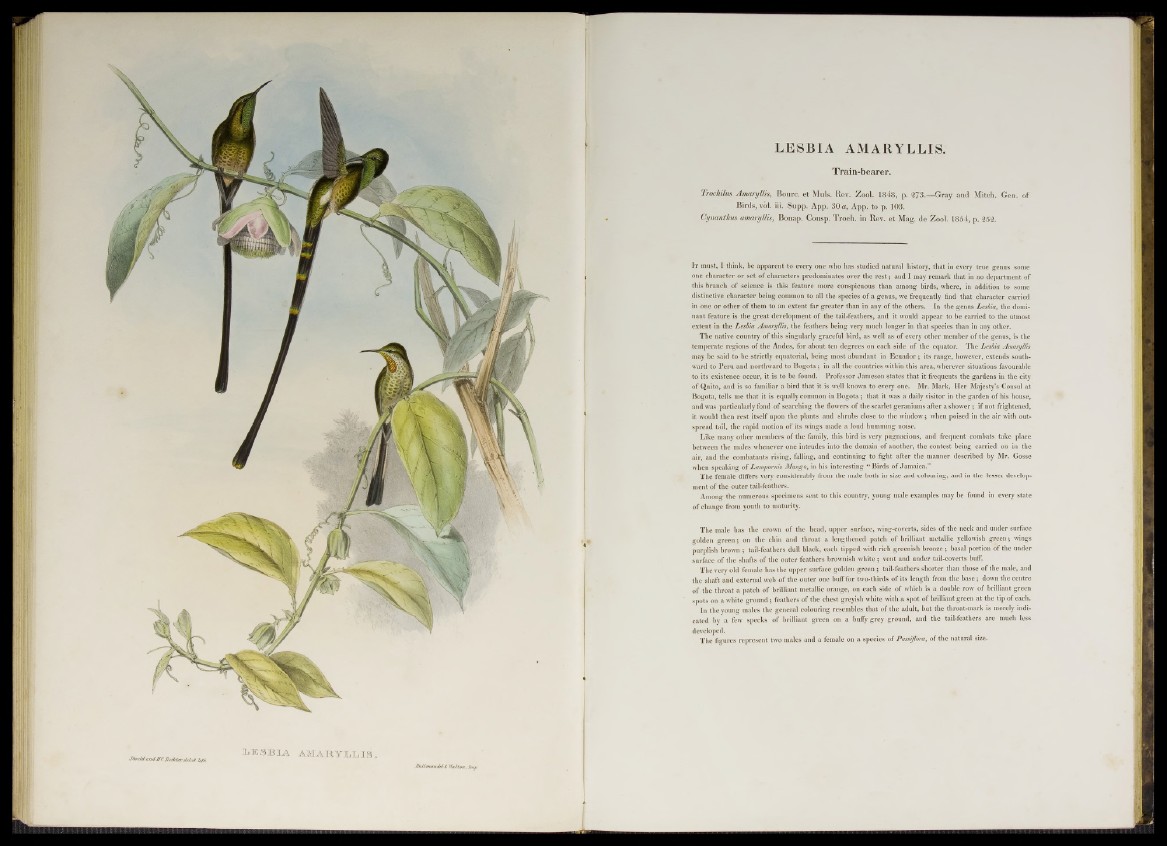
XiU S B IA AMAü YZiI jIS J û o iM a n d VG R iJ itc r; defrcl Tah
!■ î L- ïi'-sÀ 5>'£ ?'?':ïA
JluUrruxJi(¿el ¿ Wa&lxr/t, lm p.
LESBIA AMARYLLIS.
Train-bearer.
Trochilus Amaryllis, Bourc. et Muls. Rev. Zool. 1848, p. 273.—Gray and Mitch. Gen. of
Birds, vol. iii. Supp. App. 30 a, App. to p. 103.
Cynanthus amaryllis, Bonap. Consp. Troch. in Rev. et Mag. de Zool. 1854, p. 252.
It must, I think, be apparent to every one who has studied natural history, that in every true genus some
one character or set of characters predominates over the rest; and I may remark that in no department of
this branch of science is this feature more conspicuous than among birds, where, in addition to some
distinctive character being common to all the species of a genus, we frequently find that character carried
in one or other of them to an extent far greater than in any of the others. In the genus Lesbia, the dominant
feature is the great development of the tail-feathers, and it would appear to be carried to the utmost
extent in the Lesbia Amaryllis, the feathers being very much longer in that species than in any other.
The native country of this singularly graceful bird, as well as of every other member of the genus, is the
temperate regions of the Andes, for about ten degrees on each side of the equator. The Lesbia Amaryllis
may be said to be strictly equatorial, being most abundant in Ecuador; its range, however, extends southward
to Peru and northward to Bogota; in all the countries within this area, wherever situations favourable
to its existence occur, it is to be found. Professor Jameson states that it frequents the gardens in the city
of Quito, and is so familiar a bird that it is well known to every one. Mr. Mark, Her Majesty’s Consul at
Bogota, tells me that it is equally common in Bogota; that it was a daily visitor in the garden of his house,
and was particularly fond of searching the flowers of the scarlet geraniums after a shower; if not frightened,
it would then rest itself upon the plants and shrubs close to the window; when poised in the air with outspread
tail, the rapid motion of its wings made a loud humming noise.
Like many other members of the family, this bird is very pugnacious, and frequent combats take place
between the males whenever one intrudes into the domain of another, the contest being carried on in the
air, and the combatants rising, falling, and continuing to fight after the manner described by Mr. Gosse
when speaking of Lampornis Mango, in his interesting “ Birds of Jamaica.”
The female differs very considerably from the male both in size and colouring, and in the lesser development
of the outer tail-feathers.
Among the numerous specimens sent to this country, young male examples may be found in every state
of change from youth to maturity.
The male has the crown of the head, upper surface, wing-coverts, sides of the neck and under surface
«•olden green; on the chin and throat a lengthened patch of brilliant metallic yellowish green; wings
purplish brown ; tail-feathers dull black, each tipped with rich greenish bronze; basal portion of the under
surface of the shafts of the outer feathers brownish white ; vent and utider tail-coverts buff.
The very old female has the upper surface golden green ; tail-feathers shorter than those of the male, and
the shaft and external web of the outer one buff for two-thirds of its length from the base; down the centre
of the throat a patch of brilliant metallic orange, on each side of which is a double row of brilliant green
spots on a white ground; feathers of the chest greyish white with a spot of brilliant green at the tip of each.
In the young males the general colouring resembles that of the adult, but the throat-mark is merely indicated
by a few specks of brilliant green on a buffy grey ground, and the tail-feathers are much less
developed.
The fio-ures represent two males and a female on a species of Passiflora, of the natural size.